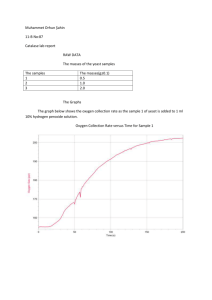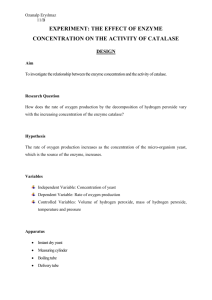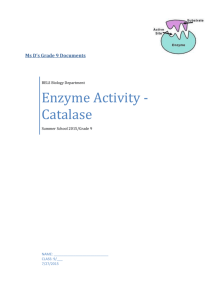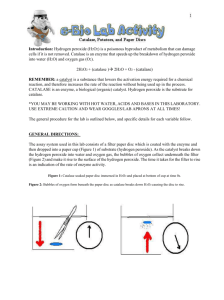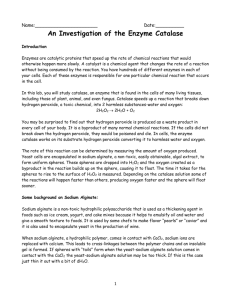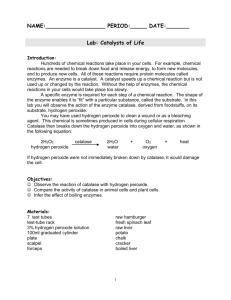Catalase Activity Lab Protocol: Yeast Spheres
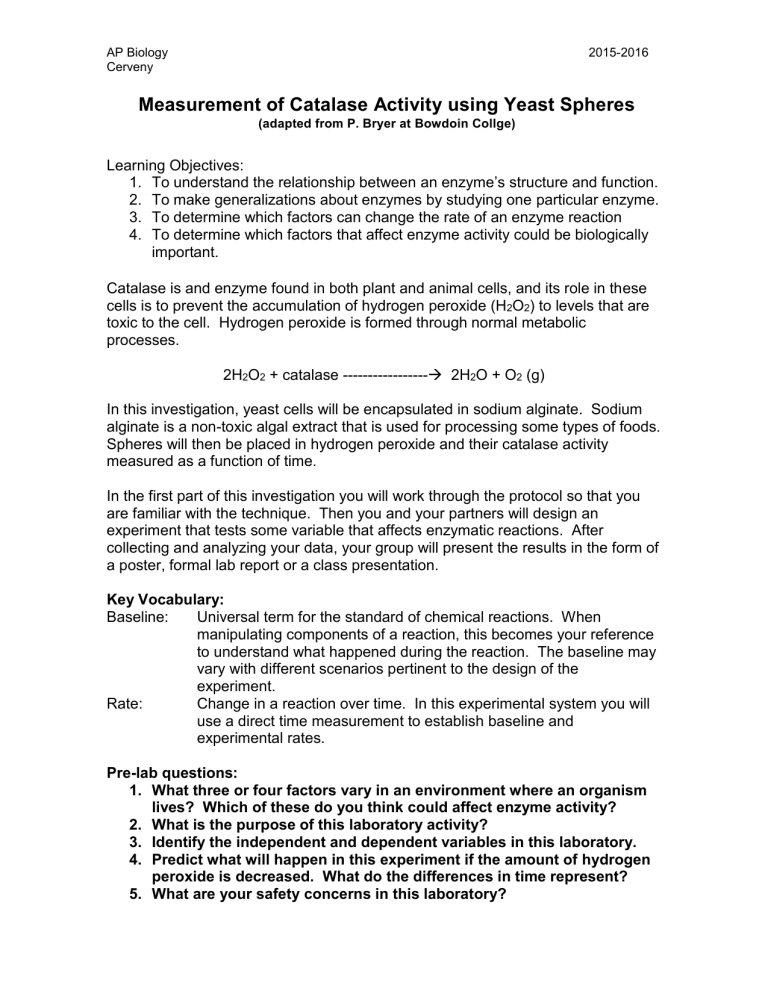
AP Biology
Cerveny
2015-2016
Measurement of Catalase Activity using Yeast Spheres
(adapted from P. Bryer at Bowdoin Collge)
Learning Objectives:
1. To understand the relationship between an enzyme
’s structure and function.
2. To make generalizations about enzymes by studying one particular enzyme.
3. To determine which factors can change the rate of an enzyme reaction
4. To determine which factors that affect enzyme activity could be biologically important.
Catalase is and enzyme found in both plant and animal cells, and its role in these cells is to prevent the accumulation of hydrogen peroxide (H
2
O
2
) to levels that are toxic to the cell. Hydrogen peroxide is formed through normal metabolic processes.
2H
2
O
2
+ catalase ---------------- 2H
2
O + O
2
(g)
In this investigation, yeast cells will be encapsulated in sodium alginate. Sodium alginate is a non-toxic algal extract that is used for processing some types of foods.
Spheres will then be placed in hydrogen peroxide and their catalase activity measured as a function of time.
In the first part of this investigation you will work through the protocol so that you are familiar with the technique. Then you and your partners will design an experiment that tests some variable that affects enzymatic reactions. After collecting and analyzing your data, your group will present the results in the form of a poster, formal lab report or a class presentation.
Key Vocabulary:
Baseline: Universal term for the standard of chemical reactions. When manipulating components of a reaction, this becomes your reference
Rate: to understand what happened during the reaction. The baseline may vary with different scenarios pertinent to the design of the experiment.
Change in a reaction over time. In this experimental system you will use a direct time measurement to establish baseline and experimental rates.
Pre-lab questions:
1. What three or four factors vary in an environment where an organism lives? Which of these do you think could affect enzyme activity?
2. What is the purpose of this laboratory activity?
3. Identify the independent and dependent variables in this laboratory.
4. Predict what will happen in this experiment if the amount of hydrogen peroxide is decreased. What do the differences in time represent?
5. What are your safety concerns in this laboratory?
AP Biology
Cerveny
2015-2016
Materials:
10% yeast solution (1 g in 10 mL dH
0.15 M CaCl
2 dH
2
0
Beakers
Inoculating loops or forceps
Funnel
2
O) 2% sodium alginate solution
Syringes (20 mL size)
Petri dishes
Graduated cylinders
Hydrogen peroxide (0.6%)
Filter paper
Safety:
Most materials in this laboratory are safe. However, hydrogen peroxide is toxic at high concentrations. In this protocol you will work with the material at a concentration of 0.6%. While unlikely to cause harm, it may still bleach fabric.
Calcium chloride is nonhazardous. Just don’t spill it or we’ll need more.
Developing a Method for Measuring Yeast Catalase Activity and Determining a Baseline:
1. Preparing yeast/alginate solution a. Add equal volumes of 10% yeast solution to a 2% sodium alginate solution, mix well with a glass rod. b. Draw yeast/alginate solution into the provided syringes. Wipe off any drops from end of the syringe.
2. Making yeast spheres a. Holding the syringe above a beaker containing 50 mL of 0.15 M
CaCl
2
. Slowly depress the solution until drops fall into the beaker. b. Continue releasing the yeast/alginate into the beaker until you have a bunch of them. Let them sit for 5 minutes at room temp to fully harden. c. Using a funnel with filter paper, carefully pour the spheres into the funnel. d. When drained, place the spheres into a beaker with 100 mL of dH
2
O. e.
Drain the spheres as in ‘c’. If not using immediately, store in a 50 mL tube containing 25 mL dH
2
O.
3. Testing catalase activity a. Pour 50 mL of the 0.6% hydrogen peroxide solution into a graduated cylinder. b. Using forceps, carefully remove 1 sphere from the petri dish. c. Decide when to start timing. As soon as the sphere touches the hydrogen peroxide it will begin to react. The sphere will sink then float back up to the top, release the gas bubbles and sink back down. d. Add the sphere to the graduated cylinder and begin your timing. e. When finished remove the sphere from the cylinder using forceps or the inoculating loop. f. Repeat test with more spheres until you have your timing down.
AP Biology
Cerveny
2015-2016
Inquiry Activity: Determine the Effect of an Environmental Factor on the
Catalase Activity in Yeast
As a group, identify a variable that will have an effect on enzymatic reactions.
Design an experiment using the yeast sphere/hydrogen peroxide system that will allow you to test this variable. You will need to write an experimental proposal before you start. In this proposal include: purpose of the experiment, what variable will you test, your hypothesis, and what will you use as controls. Define the protocol and any supplies needed (I can help here). Determine how many trials you will complete, what you will measure, how you will measure it, and why that measurement system is relevant. Also explain how you will process the data (eg. compare means, graphs). Note any safety precautions. Plan to collect your data in your lab notebook.
In the end your group will present your results as a formal report, poster or presentation. Over the course of these big experiments you will do each one of these formats at least twice. Rubrics and instructions for each method will be supplied.


